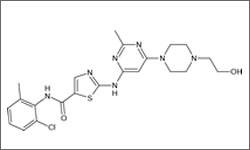Dasatinib

Dasatinib is approved for use in treatment of: Chronic, accelerated, myeloid or lymphoid blast phase chronic myeloid leukemia (CML) that is resistant to prior therapy (including imatinib), Philadelphia chromosome-positive acute lymphoblastic leukemia (ALL) resistant to prior therapy and Philadelphia chromosome-positive chronic-phase chronic myeloid leukemia (Ph+ CP-CML).1
- 1 Chu, E., & DeVita, V. T. (2015). Physicians' cancer chemotherapy drug manual 2015. Burlington, MA: Jones & Bartlett Learning.
Dasatinib (Sprycel®) is a multiple tyrosine kinase inhibitor, which means it stops harmful enzyme production. Some of its targets are bcr-abl, src, c-kit and epha2.1
The diagram above shows the 3D molecular structure of Dasatinib.
- 1 Chu, E., & DeVita, V. T. (2015). Physicians' cancer chemotherapy drug manual 2015. Burlington, MA: Jones & Bartlett Learning.
Serious side effects include: myelosuppression, neutropenia and anemia. Other side effects include bleeding complications (from platelet dysfunction), fluid retention and GI issues.1
- 1 Chu, E., & DeVita, V. T. (2015). Physicians' cancer chemotherapy drug manual 2015. Burlington, MA: Jones & Bartlett Learning.
The most common toxicities observed due to dasatinib treatment are myelosuppression (low blood counts), hemorrhage in the central nervous system or gastrointestinal tract and QT prolongation (increased duration of cardiac ventricular repolarization). There is a potential harm to the fetus in pregnant woman who receive dasatinib, therefore women should avoid becoming pregnant during this treatment and pregnant women should be warned of this risk. Due to possible drug interactions, dasatinib treatment should be avoided or closely monitored in patients receiving CYP3A4 inhibitors or inducers, antacids, proton pump inhibitors or hydrogen antagonists.1
- 1 Chu, E., & DeVita, V. T. (2015). Physicians' cancer chemotherapy drug manual 2015. Burlington, MA: Jones & Bartlett Learning.
